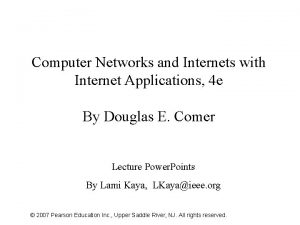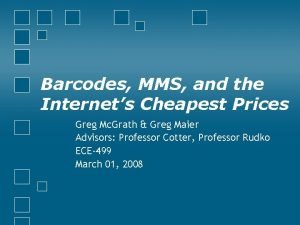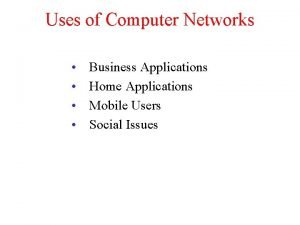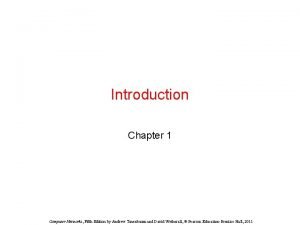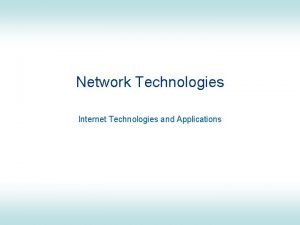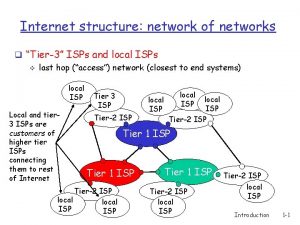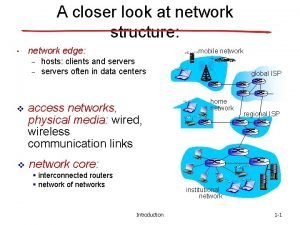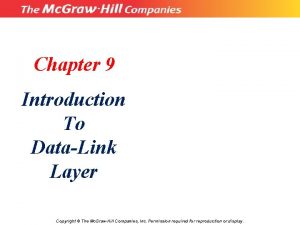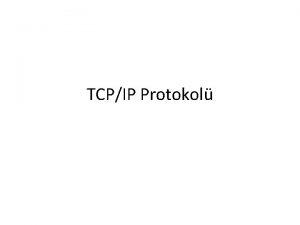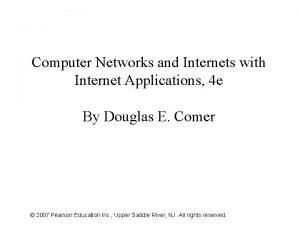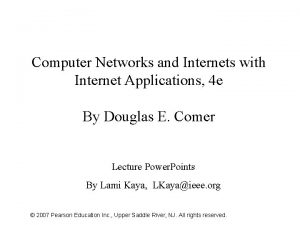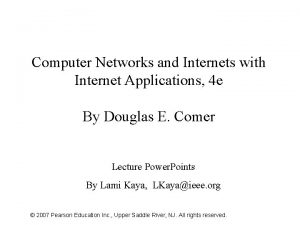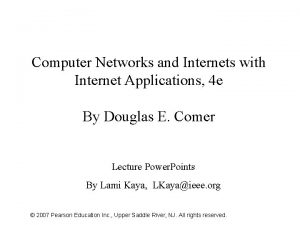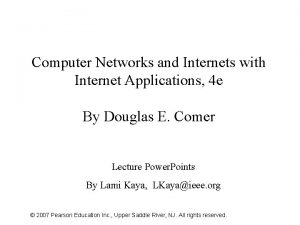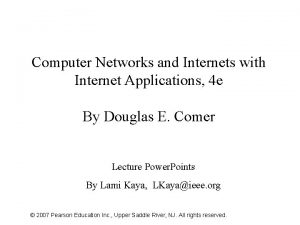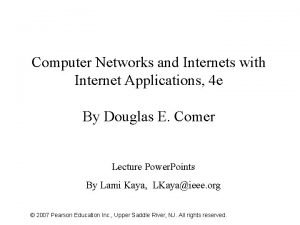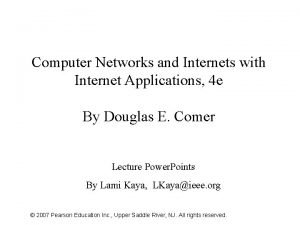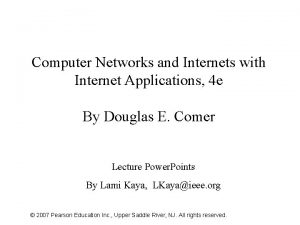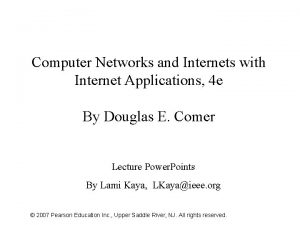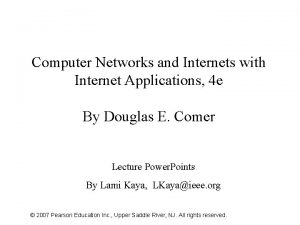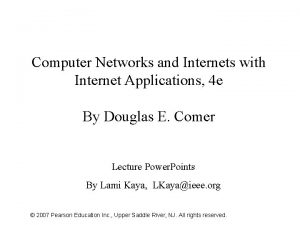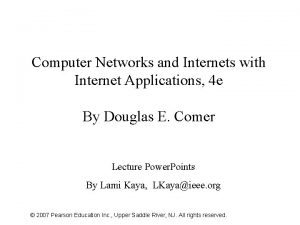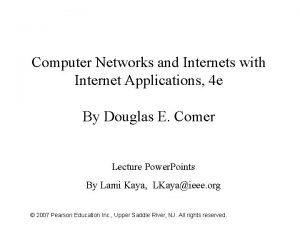Computer Networks and Internets with Internet Applications 4























- Slides: 23

Computer Networks and Internets with Internet Applications, 4 e By Douglas E. Comer Lecture Power. Points By Lami Kaya, LKaya@ieee. org © 2007 Pearson Education Inc. , Upper Saddle River, NJ. All rights reserved.

Chapter 6 Long Distance Communication © 2007 Pearson Education Inc. , Upper Saddle River, NJ. All rights reserved.

Topics Covered • • • 6. 1 Introduction 6. 2 Sending Signals Across Long Distances 6. 3 Modem Hardware Used For Modulation/Demodulation 6. 4 Leased Analog Data Circuits 6. 5 Optical, Radio Frequency, And Dialup Modems 6. 6 Carrier Frequencies And Multiplexing 6. 7 Baseband And Broadband Technologies 6. 8 Wavelength Division Multiplexing 6. 9 Spread Spectrum 6. 10 Time Division Multiplexing © 2007 Pearson Education Inc. , Upper Saddle River, NJ. All rights reserved.

6. 1 Introduction This chapter • explains why the same scheme does not work for long distances • describes the hardware needed for long-distance communication • describes the motivation for using a continuous carrier • discusses how a carrier can be used to send data • identifies the purpose of modem hardware • shows how modems are used for long-distance communication. • discusses point-to-point digital circuits and how they are used © 2007 Pearson Education Inc. , Upper Saddle River, NJ. All rights reserved.

6. 2 Sending Signals Across Long Distances (1) • Electric current cannot be propagated an arbitrary distance over copper wire – because the current becomes weaker as it travels – resistance in the wire causes small amounts of the electrical energy to be converted to heat • An interesting property of long-distance transmission – a continuous, oscillating signal will propagate farther • long-distance communication systems send a continuously oscillating signal – usually a sine wave, called a carrier • Figure 6. 1 illustrates a carrier waveform © 2007 Pearson Education Inc. , Upper Saddle River, NJ. All rights reserved.

© 2007 Pearson Education Inc. , Upper Saddle River, NJ. All rights reserved. 6

6. 2 Sending Signals Across Long Distances (2) • To send data, a transmitter modifies the carrier slightly – Collectively, such modifications are called modulation • Whether they transmit over wires, optical fibers, MW, or RF, most long-distance NW – The transmitter generates a continuously oscillating carrier signal • which it modulates according to the data being sent – The receiver on a long-distance link must be configured to recognize the carrier that the sender uses • The receiver – – monitors the incoming carrier detects modulation reconstructs the original data and discards the carrier © 2007 Pearson Education Inc. , Upper Saddle River, NJ. All rights reserved.

6. 2 Sending Signals Across Long Distances (3) • Network technologies use a variety of schemes: – Amplitude modulation (AM, ASK) • varies the strength/amplitude of the outgoing signal in proportion to the information being sent – Frequency modulation (FM, FSK) • varies the frequency of the outgoing signal – Phase modulation (PM, PSK) • varies the phase of the outgoing signal • Figure 6. 2 illustrates how a bit might be encoded © 2007 Pearson Education Inc. , Upper Saddle River, NJ. All rights reserved.

© 2007 Pearson Education Inc. , Upper Saddle River, NJ. All rights reserved. 9

6. 2 Sending Signals Across Long Distances (4) • The Nyquist theorem suggests that the rate can be increased – if the encoding scheme permits multiple bits to be encoded in a single cycle • Figure 6. 3 shows a PSK waveform • HW can measure the amount of shift – each phase shift can encode more than one bit of data – sender takes the value of a group of bits • to determine how much to shift • The chief advantage of mechanisms like PSK arises – from their ability to encode more than one bit value at a given change © 2007 Pearson Education Inc. , Upper Saddle River, NJ. All rights reserved.

© 2007 Pearson Education Inc. , Upper Saddle River, NJ. All rights reserved. 11

6. 3 Modem Hardware Used For Modulation And Demodulation (1) • HW that accepts a sequence of data bits and applies modulation to a carrier wave according to the bits – called a modulator • HW that accepts a modulated carrier wave and recreates the sequence of data bits that was used to modulate the carrier – called a demodulator • To support such full duplex communication, – each location needs both a modulator and a demodulator – manufacturers combine both circuits into a single device • called a modem ( modulator and demodulator). • Figure 6. 4 illustrates how a pair of modems © 2007 Pearson Education Inc. , Upper Saddle River, NJ. All rights reserved.

© 2007 Pearson Education Inc. , Upper Saddle River, NJ. All rights reserved. 13

6. 4 Leased Analog Data Circuits • Private companies cannot install circuits across long distances • Government regulations only allow utility companies to run wires across public property • Telephone companies allow companies to lease a circuit between any two locations – A leased circuit usually consists of four wires – Bits travel across such circuits one at a time, – we use the terms serial data circuit, serial line or leased serial line • The chief advantage of such an arrangement arises from its constant availability • The chief disadvantages arise from the limited connectivity and cost – the leased line only connects two points – pay the monthly fee even if the line is not being used to send data © 2007 Pearson Education Inc. , Upper Saddle River, NJ. All rights reserved.

6. 5 Optical, Radio Frequency, And Dialup Modems (1) • In addition to dedicated/leased wires, also others, such as: – RF transmission (RF modem) • especially attractive because of the increased interest in wireless – glass fibers (optical modem) – conventional telephone dail-up connections (dial-up modem) • As Figure 6. 5 illustrates, a dialup modem • 2 -wire dialup modems differ from 4 -wire leased-modems: – A dialup modem contains circuitry that mimics a telephone – A dialup modem uses a carrier that is an audible tone – A pair of dialup modems can offer full duplex communication: • Modems must use different carrier tones or coordinate to avoid having both modems transmit at the same time. • Modems that coordinate sending data are called half-duplex © 2007 Pearson Education Inc. , Upper Saddle River, NJ. All rights reserved.

6. 5 Optical, Radio Frequency, And Dialup Modems (2) • As an alternative to standard dialup modems, – A V. 90 or V. 92 modem uses an asymmetric scheme: • An ISP has a digital (ISDN) connection • A subscriber has a standard analog connection • the asymmetry makes it possible for the downstream path to have higher throughput • An application that uses a modem – might be able to deduce the underlying media by measuring the delay and bandwidth of the channel © 2007 Pearson Education Inc. , Upper Saddle River, NJ. All rights reserved.

© 2007 Pearson Education Inc. , Upper Saddle River, NJ. All rights reserved. 17

6. 6 Carrier Frequencies And Multiplexing • Two or more signals that use different carrier frequencies over a single medium simultaneously without interference – A receiver configured to accept a carrier at a given frequency will not be affected by signals sent at other frequencies – Multiple carriers can pass over the same wire at the same time without interference • Frequency division multiplexing (FDM) technology can be used – when sending signals over copper wire, RF, or fiber optics • Figure 6. 6 illustrates the concept • Large gaps between the carrier frequencies needed – underlying HW must tolerate a wide range of frequencies – consequently, FDM is only used on high-BW systems © 2007 Pearson Education Inc. , Upper Saddle River, NJ. All rights reserved.

© 2007 Pearson Education Inc. , Upper Saddle River, NJ. All rights reserved. 19

6. 7 Baseband And Broadband Technologies • The primary motivation for using FDM – desire for high throughput • When HW uses a larger part of the EM spectrum: – it is called broadband • Alternative technology uses a small part of the EM spectrum and sends only one signal at a time – baseband © 2007 Pearson Education Inc. , Upper Saddle River, NJ. All rights reserved.

6. 8 Wavelength Division Multiplexing • The concept of FDM can be applied to optical medium • Optical FDM – is known as wavelength division multiplexing wave (WDM) • When many wavelengths are used, – the term is Dense Wavelength Division Multiplexing (DWDM) – carriers can be mixed onto a single medium – at the receiving end, an optical prism is used to separate them © 2007 Pearson Education Inc. , Upper Saddle River, NJ. All rights reserved.

6. 9 Spread Spectrum (SS) • SS is used for a variety of reasons: – One chief reason for using SS is to improve reliability – If the transmitter and receiver are close to sources of EM interference or if large objects move around in the area between them • the optimum carrier frequency may vary over time • at a given time, one carrier frequency may work while others do not • It works as follows – A transmitter to send the same signal on a set of carrier freq. – A receiver is configured to check all carrier freq. and to use whichever is working at present – If interference damages one or more of the carriers, the modem can extract the data from the others © 2007 Pearson Education Inc. , Upper Saddle River, NJ. All rights reserved.

6. 10 Time Division Multiplexing • The general alternative to FDM is – time division multiplexing (TDM) • In TDM sources share a medium by ``taking turns'' • There are two types of TDM: – Synchronous Time Division Multiplexing (STDM) • arranges for sources to proceed in a round-robin manner • also known as Slotted Time Division Multiplexing – Statistical Multiplexing • Works similar to STDM, but if a given source does not have data to send, the multiplexor skips that source • Most NW use a form of statistical multiplexing because computers do not all generate data at exactly the same rate © 2007 Pearson Education Inc. , Upper Saddle River, NJ. All rights reserved.
 Computer networks and internets with internet applications
Computer networks and internets with internet applications Computer networks and internets
Computer networks and internets Packet switching datagram and virtual circuit approach
Packet switching datagram and virtual circuit approach Compare internets
Compare internets Basestore iptv
Basestore iptv Business applications in computer networks
Business applications in computer networks Principles of network applications in computer networks
Principles of network applications in computer networks Business application in computer network
Business application in computer network Business application in computer network
Business application in computer network Internet transport protocol in computer networks
Internet transport protocol in computer networks Aim lans
Aim lans Tier 3 isps
Tier 3 isps Internet structure network of networks
Internet structure network of networks Which type of address is this: a3:34:45:11:92:f1
Which type of address is this: a3:34:45:11:92:f1 Osi vs tcp/ip
Osi vs tcp/ip Difference between intserv and diffserv
Difference between intserv and diffserv Checksum in computer networks with example
Checksum in computer networks with example Bit and byte stuffing
Bit and byte stuffing Character stuffing in computer networks
Character stuffing in computer networks Arp rarp protocol
Arp rarp protocol Analog and digital signals in computer networking
Analog and digital signals in computer networking Web and http in computer networks
Web and http in computer networks Error detection and correction in computer networks
Error detection and correction in computer networks Protocols and standards in computer networks
Protocols and standards in computer networks

